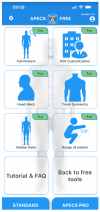Scoliosis Management through Apps and Software Tools
- PMID: 37107802
- PMCID: PMC10138677
- DOI: 10.3390/ijerph20085520
Scoliosis Management through Apps and Software Tools
Abstract
Background: Scoliosis is curvature of the spine, often found in adolescents, which can impact on quality of life. Generally, scoliosis is diagnosed by measuring the Cobb angle, which represents the gold standard for scoliosis grade quantification. Commonly, scoliosis evaluation is conducted in person by medical professionals using traditional methods (i.e., involving a scoliometer and/or X-ray radiographs). In recent years, as has happened in various medicine disciplines, it is possible also in orthopedics to observe the spread of Information and Communications Technology (ICT) solutions (i.e., software-based approaches). As an example, smartphone applications (apps) and web-based applications may help the doctors in screening and monitoring scoliosis, thereby reducing the number of in-person visits. Objectives: This paper aims to provide an overview of the main features of the most popular scoliosis ICT tools, i.e., apps and web-based applications for scoliosis diagnosis, screening, and monitoring. Several apps are assessed and compared with the aim of providing a valid starting point for doctors and patients in their choice of software-based tools. Benefits for the patients may be: reducing the number of visits to the doctor, self-monitoring of scoliosis. Benefits for the doctors may be: monitoring the scoliosis progression over time, managing several patients in a remote way, mining the data of several patients for evaluating different therapeutic or exercise prescriptions. Materials and Methods: We first propose a methodology for the evaluation of scoliosis apps in which five macro-categories are considered: (i) technological aspects (e.g., available sensors, how angles are measured); (ii) the type of measurements (e.g., Cobb angle, angle of trunk rotation, axial vertebral rotation); (iii) availability (e.g., app store and eventual fee to pay); (iv) the functions offered to the user (e.g., posture monitoring, exercise prescription); (v) overall evaluation (e.g., pros and cons, usability). Then, six apps and one web-based application are described and evaluated using this methodology. Results: The results for assessment of scoliosis apps are shown in a tabular format for ease of understanding and intuitive comparison, which can help the doctors, specialists, and families in their choice of scoliosis apps. Conclusions: The use of ICT solutions for spinal curvature assessment and monitoring brings several advantages to both patients and orthopedics specialists. Six scoliosis apps and one web-based application are evaluated, and a guideline for their selection is provided.
Keywords: Cobb angle; angle of trunk rotation (ATR); app; axial vertebral rotation (AVR); scoliometer; scoliosis; scoliosis management.
Conflict of interest statement
The authors declare no conflict of interest.
Figures









References
-
- Maggio D., Ailon T., Kelleher J., Ames C., Shaffrey C., Smith J. Youmans and Winn Neurological Surgery. 7th ed. Elsevier; Philadelphia, PA, USA: 2017. Evaluation and treatment of adult scoliosis and sagittal plane deformity.
-
- Greiner A.K. Adolescent idiopathic scoliosis: Radiologic decision-making. Am. Fam. Physician. 2002;65:1817. - PubMed
Publication types
MeSH terms
LinkOut - more resources
Full Text Sources
Medical
Research Materials
Miscellaneous

